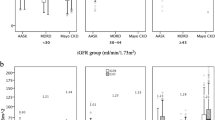Abstract
Purpose
Dose modification in renal impairment has traditionally been based on changes in estimated glomerular filtration rate (eGFR; estimated by creatinine clearance). However, many drugs are eliminated by tubular anionic and cationic transport where changes in eGFR may not necessarily reflect changes in tubular function. This study investigated the relationship between GFR and renal tubular function with reference to drug handling by using accepted drug probes.
Methods
Three drug probes, 51Cr-EDTA, fluconazole, and pindolol, were administered to patients who had varying degrees of renal impairment. Blood sampling, assays, and a pharmacokinetic analysis were performed for all drug probes and endogenous urate. Measured GFR (51Cr-EDTA clearance; mGFR) was compared to tubular anionic transport (urate clearance), tubular reabsorption (fluconazole clearance), and tubular cationic transport (S-pindolol clearance).
Results
A moderately strong association was demonstrated between the measured isotopic GFR and creatinine clearance (R2 = 0.78). A moderate positive correlation was found between mGFR and proximal tubular anion transport and reabsorption (R2 = 0.40–0.44, p < 0.0001). In contrast, cationic secretion correlated poorly with mGFR (R2 = 0.11, p = 0.036).
Conclusions
Given that drug dosing schedules utilise eGFR values as the basis for modifying drug dosing, our results would suggest that a recommendation of a dose reduction according to eGFR alone should be treated with caution.


Similar content being viewed by others
References
Vidal L, Shavit M, Fraser A, Paul M, Leibovici L (2005) Systematic comparison of four sources of drug information regarding adjustment of dose for renal function. BMJ 331(7511):263. doi:10.1136/bmj.38476.471088.3A
Botev R, Mallie JP, Wetzels JF, Couchoud C, Schuck O (2011) The clinician and estimation of glomerular filtration rate by creatinine-based formulas: Current limitations and quo vadis. Clin J Am Soc Nephrol 6(4):937–950. doi:10.2215/CJN.09241010
Dontas AS, Marketos SG, Papanayiotou P (1972) Mechanisms of renal tubular defects in old age. Postgrad Med J 48(559):295–303
Lindeman RD (1990) Overview: Renal physiology and pathophysiology of aging. Am J Kidney Dis 16(4):275–282
Lindeman RD (1992) Changes in renal function with aging. Implications for treatment. Drugs Aging 2(5):423–431
Lindeman RD (1993) Renal physiology and pathophysiology of aging. Contrib Nephrol 105:1–12
(K/DOQI) KDOQI (2002) K/DOQI clinical practice guidelines for chronic kidney disease: Evaluation, classification, and stratification. Am J Kidney Dis 39:S1–S246
Nolin TD, Naud J, Leblond FA, Pichette V (2008) Emerging evidence of the impact of kidney disease on drug metabolism and transport. Clin Pharmacol Ther 83(6):898–903. doi:10.1038/clpt.2008.59
Tett SE, Kirkpatrick CM, Gross AS, McLachlan AJ (2003) Principles and clinical application of assessing alterations in renal elimination pathways. Clin Pharmacokinet 42(14):1193–1211
Gross AS, McLachlan AJ, Minns I, Beal JB, Tett SE (2001) Simultaneous administration of a cocktail of markers to measure renal drug elimination pathways: absence of a pharmacokinetic interaction between fluconazole and sinistrin, p-aminohippuric acid and pindolol. Br J Clin Pharmacol 51(6):547–555
McLachlan AJ, Gross AS, Beal JL, Minns I, Tett SE (2001) Analytical validation for a series of marker compounds used to assess renal drug elimination processes. Ther Drug Monit 23(1):39–46
Andreev E, Koopman M, Arisz L (1999) A rise in plasma creatinine that is not a sign of renal failure: which drugs can be responsible? J Intern Med 246(3):247–252
Cappuccio FP, Iacone R, Strazzullo P (1991) Serum uric acid and proximal sodium excretion: an independent association in man (the Olivetti Study). J Hypertens Suppl 9(6):S280–S281
Beal JL, Tett SE (1998) Determination of pindolol enantiomers in human plasma and urine by simple liquid-liquid extraction and high-performance liquid chromatography. J Chromatogr B Biomed Sci Appl 715(2):409–415
Kim SS, Im HT, Kang IM, Lee HS, Lee HW, Cho SH, Kim JB, Lee KT (2007) An optimized analytical method of fluconazole in human plasma by high-performance liquid chromatography with ultraviolet detection and its application to a bioequivalence study. J Chromatogr B Anal Technol Biomed Life Sci 852(1–2):174–179. doi:10.1016/j.jchromb.2007.01.012
Chantler C, Garnett ES, Parsons V, Veall N (1969) Glomerular filtration rate measurement in man by the single injection methods using 51Cr-EDTA. Clin Sci 37(1):169–180
Du Bois D, Du Bois EF (1989) A formula to estimate the approximate surface area if height and weight be known. 1916. Nutrition 5(5):303–311, discussion 312–303
Maesaka JK, Fishbane S (1998) Regulation of renal urate excretion: a critical review. Am J Kidney Dis 32(6):917–933
Acknowledgments
This study was funded by a Laurenson Grant awarded from the Otago Medical Research Foundation. Dr Putt was the recipient of an Otago University Emily Johnston Scholarship. Mr Ashley Duncan, Department of Human Nutrition, University of Otago, kindly undertook the pindolol and fluconazole assays as well as the routine biochemical assays. This work was presented in abstract form at the World Congress of Nephrology, Hong Kong 2013.
Conflict of interest
The authors have no financial conflicts of interest.
Author contributions
Dr Putt planned and conducted the study, analysed the GFR, and was the primary author of the manuscript. Professor Walker was the primary investigator and co-wrote the manuscript. Professor Duffull conducted the NONMEM analysis and assisted with manuscript preparation. Dr Schollum was involved in the planning of the study along with the other authors.
Author information
Authors and Affiliations
Corresponding author
Electronic supplementary material
Below is the link to the electronic supplementary material.
ESM 1
(DOC 246 kb)
Rights and permissions
About this article
Cite this article
Putt, T.L., Duffull, S.B., Schollum, J.B.W. et al. GFR may not accurately predict aspects of proximal tubule drug handling. Eur J Clin Pharmacol 70, 1221–1226 (2014). https://doi.org/10.1007/s00228-014-1733-7
Received:
Accepted:
Published:
Issue Date:
DOI: https://doi.org/10.1007/s00228-014-1733-7




